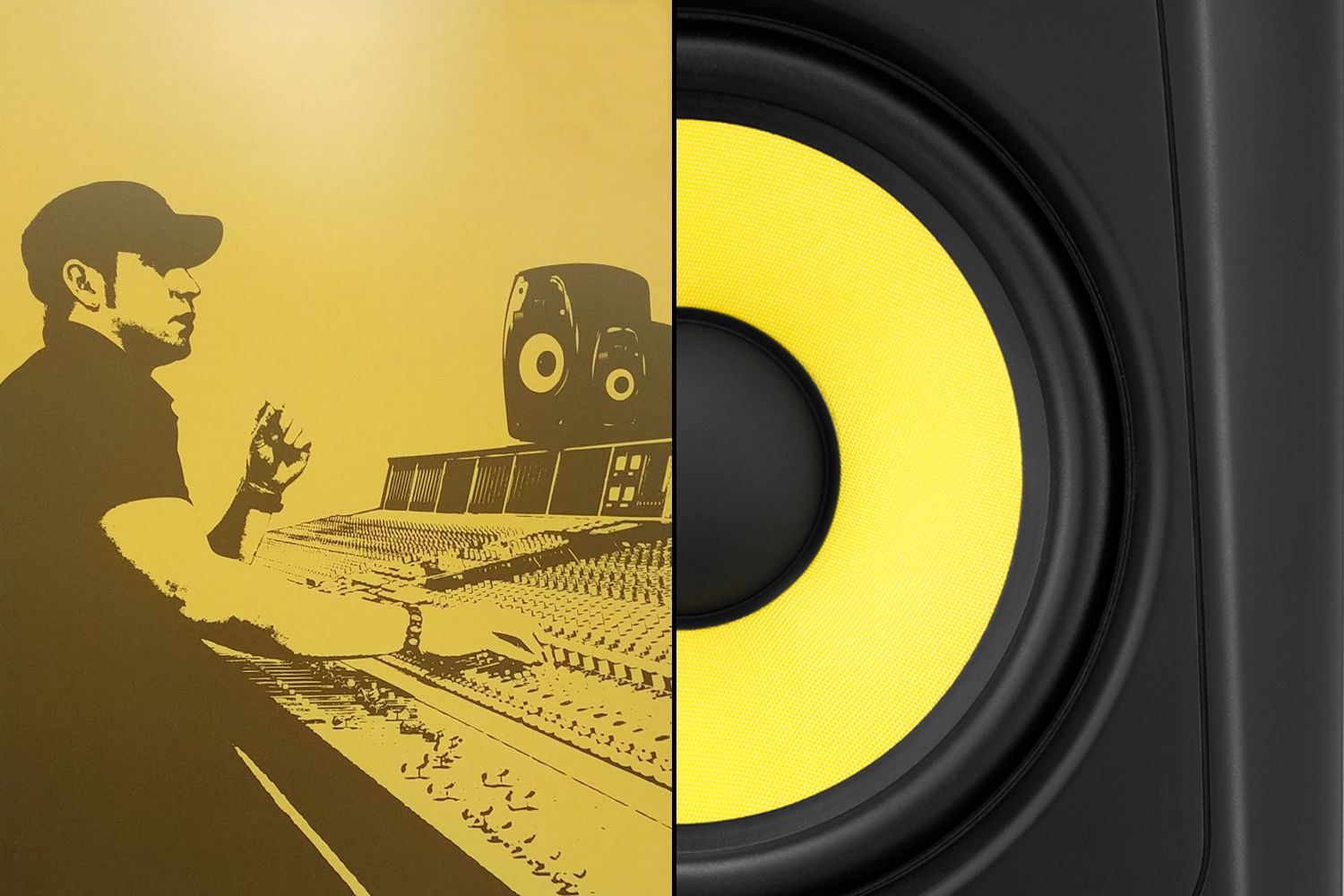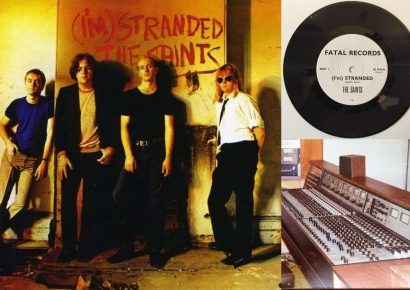An ode to the bass-heavy, yellow-coned mainstays of the home studio sector.
For the musically inclined, you can barely go anywhere without seeing a KRK monitor lurking somewhere in the background.
The iconic yellow and black speaker has been the de-facto monitor for an entire generation of bedroom beat makers, DJs and synth obsessives who have come up, having learnt to mix exclusively on the very unique and very singular sounding speakers. They are simply a part of the modern studio ecosystem: their very accessible price point and very present sonic character having well and truly resonated with the masses, who praise them for their versatility, broad frequency profile and the often underrated ability to ‘just sound good’ across multiple applications.
Read all the latest features, columns and more here.
If Funktion Ones are the sound of the modern festival or club system, then KRKs are the sound of the modern electronic production space: a speaker so perfectly suited to a particular application that it has undeniably shaped the sonic output of not just one, but any number of electronic sub-genres that rely on extended low frequency response and an ease of translatability between controlled and uncontrolled environments.
Founded in 1986 by film mix engineer, Keith R Klawitter, KRK spent a decade as the bespoke choice for the booming broadcast and commercial recording industries before emerging in the 2000s as the monitor of choice for the burgeoning electronic production set, with a sound and aesthetic all its own. From humble beginnings, the brand’s ‘design first’ mentality was there from the offset, with Keith hand making the speakers from scratch after being dissatisfied with the monitor choices available of the time. Seeking more clarity and punch for his film work, Keith cut his teeth making commission speakers for both the studio and live domains, before moving into the retail sector and morphing into the KRK we know today.
With their reputation for bombproof build quality and armed with a unique and functional voicing, the KRK brand quickly cemented itself into the studio landscape in a way that seemed to perfectly coincide with the emergence of the DAW and VST-based dance music in the 2000s.
Anybody working in this space will only be too familiar with the KRK sound: chiseled and defined, with the ability to accurately reproduce the increasingly lower kick fundamentals and guttural sub bass frequencies that have become a staple of the modern electronic palate. With its extended LF response, broad soundstage and ability to provide some much needed clarity in the lower harmonics (in turn, creating multi-band compression and 808 sub work a breeze), the KRK has emerged as the monitor best suited to facilitate these kind of strange new sonic textures.
In my experience, I’ve produced, listened and worked on KRK speakers at friends houses and studios probably more than any other monitoring setup, not just here in Australia, but anywhere around the globe. They are almost universal in their appeal; their iconic yellow and black drivers being just as at home parked next to a classic SL1200-type setup as they are in a bedroom DAW studio or even just sitting on a shelf in a lounge room, with KRK monitors also doubling as an equally adept and enjoyable speaker for the home listener.
In the dance music community, KRK monitors are nothing short of omnipresent: a fact that makes even more sense when you take into account how well their unique voicing translates to larger systems and club environments. For dance producers, knowing how to mix on KRKs is one of those skills that is sure to pay endless dividends, especially when it comes to having tracks flourish on a full range club system.
At time of writing, KRK offers three styles of monitors: the entry level Classic monitors, the ubiquitous Rokit series of powered monitors and, at the higher end of the range, the premium V series. For those who cut their teeth on the Rokit series, the new fourth generation V series are sure strike a chord with anybody looking to combine familiarity with the very best in cutting edge monitor design. Available in 4”, 6” and 8” in variants the V series has plenty to offer for the nearfield and midfield, meaning plenty of flexibility for different monitoring environments and applications.
The wider bass port on the V series will be a feature all too familiar to KRK acolytes, allowing for a more even bass distribution than a traditional ported cylinder design. Having this port on the front of the unit, rather than the back, allows for the speakers to ‘breathe’ with out issue, in turn minimising reflections and helping to alleviate some of the inherent bass build up that occurs when placing a speaker close to a wall – a must have feature for home producers with limited space available.
The S4 V series are the result of generations of evolution and refinement. Whereas the first generation of the V series speakers came with relatively sharp corners and a reasonably boxy exterior, the most recent incarnation cuts a much more striking and tech-savvy figure, with its moulded outer and sleek curves giving it a dangerously sophisticated appearance. More than just a pretty face, this cabinet shape has its own technical merits, with KRK noting that the new enclosure design has the added bonus of a broader dispersion and wider pan, splaying the sound from the tweeter and woofer in a more even distribution and allowing for a wider sweet spot and broader soundstage than generations past.
The presence of KRK’s patented Kevlar woofers (a standout feature over the last few generations of the V series), give the speakers that same extended low end that made the KRK name, but with an increased durability and a focus on a balanced and present mid-range-perfect for critical listening and decision making. This focus on balance and transparency at the listening position has only served to make the line even more desirable in the eyes of DJ’s and producers. With more and more emphasis being placed on recorded output in the DJ space, there has never been more stresses being placed on the finer details of electronic music composition and mixing for the home listener, and in this regard a monitor like the KRK V series makes perfect sense.
With an improved cabinet design that has been tweaked to create a lower resonance environment (in turn resulting in less sound wave propagation and a more trustworthy reference point at the listening position), the latest incarnation of the V series really do mark a coming of age, both for the product line and the army of maturing beat makers who have grown up with the Rokit series as their go-to.
A pre-installed foam base provides a default level of decoupling straight out of the box, in turn allowing for better isolation and a truer response than most when placed directly on a hard surface like a studio desk or DJ booth. The ability to handle sub bass is still there, but is more balanced and defined, allowing for better decision-making even without the aid of a separate studio sub. This proves to be a big bonus, especially for producers on a budget or where room dimensions/noise factors may not allow for far field or sub configurations.
While the brand may have come to prominence for their sightly scooped/hyped voicing endemic to the Rokit series, the V series of speakers are a much more ‘true’ and critical affair. But don’t fret KRK purists—there’s a new LED DSP on the back of the G4’s which allow you to select up to 49 different EQ combinations including boosts to the bass and high frequencies, meaning producers can switch between a flatter, more critical setting for fine tuning before switching to the classic KRK curve to get mixes club ready. Additionally, standby mode and output levels can be tweaked via this new feature. Inputs on the back of the cabinet have been streamlined into a combo jack supporting both XLR and TRS types of connectors.
Every genre has its de-facto monitor and in the hyper-reality of modern electronic music production (where the bass is bassier, compression is side-chained and you live and die by the quality of the kick) there is simply no surer bet than a pair of trusty KRKs. Having already owned the space for the better part of two decades, KRK are still in fine form, and their more recent V series releases only further solidify their position as the industry standard for the diverse number of applications found on the modern electronic space.
With some timely and clever improvements made to the classic KRK formula, the new and improved S4’s mark an evolution for the brand, echoing a maturation in their target demographic, as electronic producers become increasingly concerned with tonal refinement, just as they are with broadband sonic bombast. By keeping an ear to the ground and staying true to Keith Klawitter’s vision of designing the ‘right’ monitors for the right application, KRK have ensured that Keith’s legacy will endure into 2021 and beyond.
For all inquiries surrounding the KRK monitor range, visit Jands.







